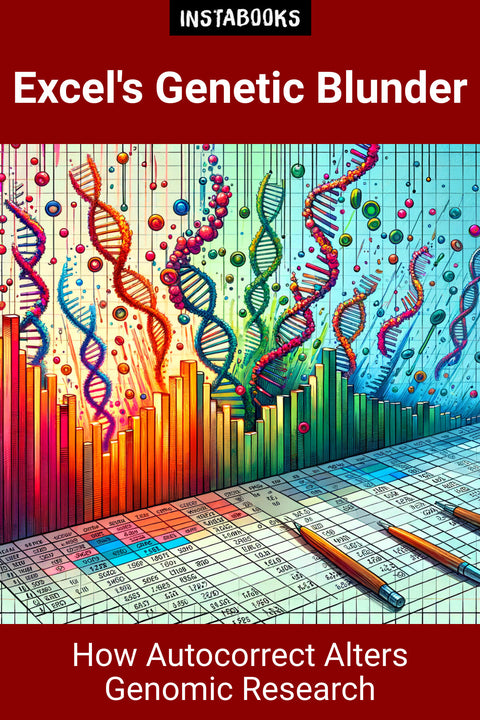
Excel's Genetic Blunder
How Autocorrect Alters Genomic Research
Included:
✓ 200+ Page AI-Generated Book
✓ ePub eBook File — read on Kindle & Apple Books
✓ PDF Print File (Easy Printing)
✓ Word DOCX File (Easy Editing)
✓ Hi-Res Print-Ready Book Cover (No Logo Watermark)
✓ Full Commercial Use Rights — keep 100% of royalties
✓ Publish under your own Author Name
✓ Sell on Amazon KDP, IngramSpark, Lulu, Blurb & Gumroad to millions of readers worldwide
Unveiling the Invisible: Excel's Impact on Genetic Research
In the world of genetic research, accuracy and precision are paramount. Yet, a surprising villain emerges in the form of a ubiquitous tool: Microsoft Excel. This book delves into how Excel’s autocorrect feature inadvertently alters crucial data, specifically focusing on the conversion of gene names into incorrect formats like dates or numbers. It's a revelation about how software intended to facilitate data handling can inadvertently become a source of error, affecting the reproducibility and verification of scientific studies.
The Extent of the Issue: A Widespread Problem
Between 2014 and 2020, it is estimated that about 20% of genetics papers had errors resulting from Excel’s gene name autocorrect feature. These errors are not isolated but rather widespread, with studies indicating a persistence in such errors, affecting around 30% of supplementary gene lists in publications. The prevalence of these errors has substantial implications for data integrity, scientific reliability, and overall trust in published genetics research.
Consequences for Scientific Research
The transformation of gene names causes confusion at the most basic level of data entry and analysis, leading to incorrect interpretations of genetic data. This book explores the ramifications of these errors on the field of genetics, highligting real-world examples of how research findings and conclusions could be drastically altered or deemed unreliable due to Excel's automatic corrections.
Steps Towards Mitigation
Efforts to counteract this problem have been ongoing. With input from organizations such as the Human Gene Name Consortium, problematic gene names have been altered to lessen the frequency of these errors. Notably, genes like 'MARCH1' were renamed to 'MARCHF1'. Additionally, this book provides recommendations and strategies for researchers to prevent such errors, promoting the use of programming tools over traditional spreadsheets for higher precision and reliability.
The Ongoing Battle
Despite measures to address this issue, gene name errors continue to be a significant hurdle in ensuring scientific accuracy. This book fuels the dialogue on the need for a paradigm shift in how genetic data is processed and shared, emphasizing a collective move towards enhanced computational methods to ensure the fidelity of scientific communication.
Table of Contents
1. Introduction to Gene Name Conversion Errors- The Birth of an Unexpected Problem
- Understanding Excel's Autocorrect Feature
- Initial Discoveries and Reactions
2. The Scale of the Issue
- Statistical Insights from Recent Studies
- Understanding the Widespread Impact
- Exploring Case Studies of Errors
3. How Autocorrect Alters Data
- Mechanics of Gene Name Conversion
- Types of Errors Observed
- Why These Errors Persist
4. The Impact on Genetic Research
- Repercussions in Data Interpretation
- Challenges in Research Replication
- Scientific Community's Response
5. Mitigation Strategies and Solutions
- Human Gene Name Consortium's Role
- Renaming Genes to Prevent Errors
- Practical Guidelines for Researchers
6. Advanced Tools for Data Handling
- Embracing Programming Languages
- Transitioning from Spreadsheets
- Ensuring Data Accuracy and Precision
7. Cultural Shift in Data Management
- Global Initiatives and Responses
- Educating Emerging Scientists
- The Future of Data Processing
8. Scientific Reproducibility and Integrity
- Understanding the Reproducibility Crisis
- The Importance of Data Integrity
- Excel's Role in Ongoing Challenges
9. The Role of Software in Scientific Errors
- Historical Overview of Software Issues
- Analyzing the Current Landscape
- Technological Dependence in Research
10. Future Directions in Gene Name Processing
- Anticipating Emerging Challenges
- Innovative Solutions on the Horizon
- Building a Resilient Research Community
11. Lessons from Gene Name Errors
- What We Have Learned So Far
- Implementing Lessons across Disciplines
- Towards a New Era of Accuracy
12. Conclusion and Call to Action
- Summary of Essential Insights
- Engaging the Wider Scientific Community
- Towards Collaborative Solutions
Target Audience
This book is intended for genetics researchers, data scientists, and academic professionals interested in understanding the impact of software on scientific research accuracy.
Key Takeaways
- Understanding the prevalence and impact of gene name errors in genetic research.
- Insights into Excel's autocorrect feature and its unintended consequences.
- Strategies and recommendations to prevent data errors in scientific studies.
- The role of human oversight and organizational efforts in mitigating errors.
- Exploration of advanced tools and methodologies for accurate data processing.
- Importance of scientific reproducibility and data integrity.
